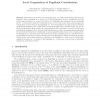WDAG
2007
Springer
15 years 1 months ago
2007
Springer
We introduce the problem of load-distance balancing in assigning users of a delay-sensitive networked application to servers. We model the service delay experienced by a user as a ...
WDAG
2007
Springer
15 years 1 months ago
2007
Springer
The timestamp problem captures a fundamental aspect of asynchronous distributed computing. It allows processes to label events throughout the system with timestamps that provide in...
WAW
2007
Springer
15 years 1 months ago
2007
Springer
Motivated by the problem of detecting link-spam, we consider the following graph-theoretic primitive: Given a webgraph G, a vertex v in G, and a parameter δ ∈ (0, 1), compute th...
WAW
2007
Springer
15 years 1 months ago
2007
Springer
We present a new stochastic model for complex networks, based on a spatial embedding of the nodes, called the Spatial Preferred Attachment (SPA) model. In the SPA model, nodes have...
WAW
2007
Springer
15 years 1 months ago
2007
Springer
WAW
2007
Springer
15 years 1 months ago
2007
Springer
A random graph model based on Kronecker products of probability matrices has been recently proposed as a generative model for large-scale real-world networks such as the web. This...
WAW
2007
Springer
15 years 1 months ago
2007
Springer
WAW
2007
Springer
15 years 1 months ago
2007
Springer
Inspired by the recent interest in combining geometry with random graph models, we explore in this paper two generalizations of the random dot product graph model proposed by Kraet...
WAW
2007
Springer
15 years 1 months ago
2007
Springer
Abstract. We study the relation between PageRank and other parameters of information networks such as in-degree, out-degree, and the fraction of dangling nodes. We model this relat...
WAW
2007
Springer
15 years 1 months ago
2007
Springer
Social networks are ubiquitous. The discovery of close-knit clusters in these networks is of fundamental and practical interest. Existing clustering criteria are limited in that cl...



